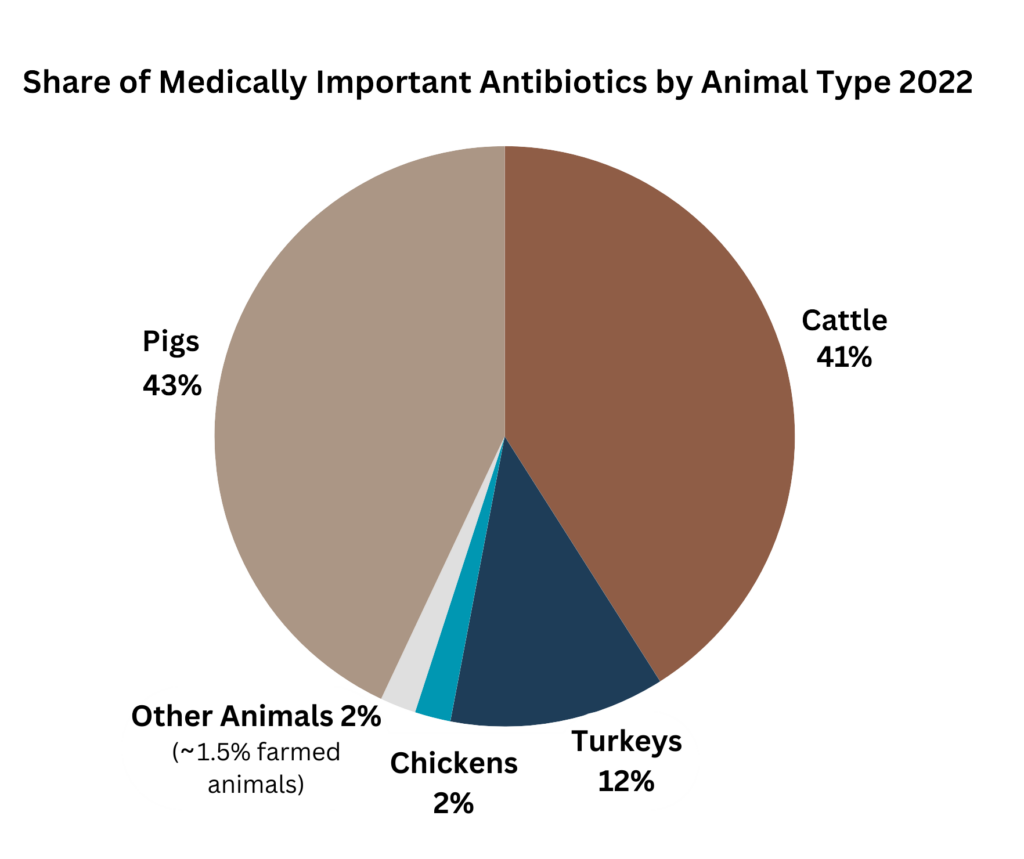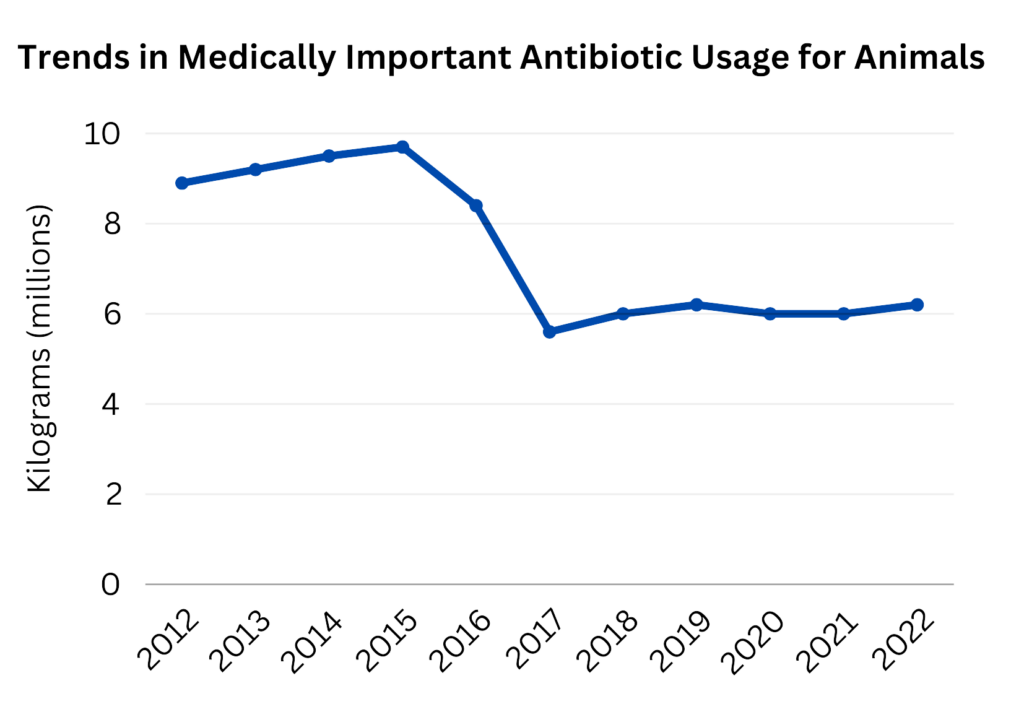It is estimated that about two-thirds of all medically important antibiotics were used for animal food production in 2019 and 2020.[1-6]

Since the FDA does not provide total human use, these estimates rely on credible but unverifiable sources.[7]
FDA (2023) 2022 Summary Report On Antimicrobials Sold or Distributed for Use in Food-Producing Animals, Tables 4a & 4b. [Provides farmed animal totals through 2022. However, we are not aware of human use totals after 2020.]
David Wallinga (2022) U.S. Livestock Industries Persist in High-intensity Antibiotic Use, Issue Brief, IB: 22-II-A, National Resources Defense Council [Note: This report provides human use totals through 2019 as well as excellent overview with key resources. We are not aware of other credible sources for human use figures. Dr. Wallinga is a researcher and recognized expert; NRDC has been at the forefront of research and advocacy in this area.]
David Wallinga (September 2023) Antibiotic Use Remains Far Too Intensive in U.S. Livestock, National Resources Defense Council. https://www.nrdc.org/bio/david-wallinga-md/antibiotic-use-remains-far-too-intensive-us-livestock [Provides human use totals through 2020]
Note: Based on the FDA’s detailed explanations of “other animals,” we broadly estimate that about two-thirds are animals farmed for food. A quick estimate of biomass of animals slaughtered for food other than cattle, pigs, chickens and turkeys (e.g., ducks, sheep, goats, and bison) and their approximate total biomass, suggests they equal ~2% of total farmed biomass. Therefore, an estimate of ~2% of antibiotic use appears reasonable. The other portion (~1%) is assumed to be from the other named categories, i.e., domestic animals (dogs, horses), uses in aquaculture, and “unknown uses.” Also note that the FDA uses the term “sold for use” instead of “used” since they cannot confirm actual usage; to simplify language we say “used.”
Note: The dip in human use in 2020 is likely due to Covid-19. See, CDC, COVID-19 Impacts on Antibiotic Use. [In outpatient settings (the primary usage), antibiotic use significantly dropped in 2020 compared to 2019.]
U.S. FDA (2022). 2021 Summary Report On Antimicrobials Sold or Distributed for Use in Food-Producing Animals, p. 3, fn.1. [Medically important antimicrobials “are those antimicrobials that have been determined to be medically important to human medicine.”]
The FDA does not offer estimates of the total antibiotic usage for humans for reasons that appear vague or not relevant. Their reasons include: the comparatively large population of animals, their larger weights, the varying durations and dosages of treatment, and some unknowns regarding companion animal usage. Given that this is probably the single most sought-after figure, as well as a key indicator of progress in terms of ongoing reductions, it seems surprising that the FDA cannot provide an estimate. For details on their rationale, see, 2021 Summary Report On Antimicrobials Sold or Distributed for Use in Food-Producing Animals, pp. 6-7.

U.S. FDA (2023) 2022 Summary Report On Antimicrobials Sold or Distributed for Use in Food-Producing Animals, Tables 4a & 4b. [Provides farmed animal totals for 2016 through 2022. We use 2020 because of a lack of more recent estimates for human use.]
David Wallinga (September 2023) Antibiotic Use Remains Far Too Intensive in U.S. Livestock, National Resources Defense Council. https://www.nrdc.org/bio/david-wallinga-md/antibiotic-use-remains-far-too-intensive-us-livestock [Provides human use totals through 2020.]
Note: A ballpark estimate of usage for 2022 is ~65%. Assuming human antibiotic use rebounded after Covid-19 back to ~3.3 million kilograms, and using FDA’s 2022 animal use figure of ~6.2 million kg., then 6.2/9.5 = ~65%.

FDA (2023) 2022 Summary Report On Antimicrobials Sold or Distributed for Use in Food-Producing Animals, Tables 4a & 4b.
The most recent FDA data for 2022 shows a 4% increase from 2021 for farmed animal usage, continuing an upward trend since 2017.[1,2]
In 2017 the FDA completed a process begun in 2013 that transitioned medically important antibiotics from over-the-counter to requiring veterinary oversight; the agency also disallowed their use for purposes of growth promotion.[3,4] This action caused the dip in overall usage from 2015 through 2017.

For years 2012-2015, see, U.S. FDA (2018) 2017 Summary Report On Antimicrobials Sold or Distributed for Use in Food-Producing Animals, Table 6b.
For years 2016-2022, see, U.S. FDA (2023) 2022 Summary Report On Antimicrobials Sold or Distributed for Use in Food-Producing Animals, Table 4b.
U.S. FDA (2018) 2017 Summary Report On Antimicrobials Sold or Distributed for Use in Food-Producing Animals, p. 3. [Note: This report finalized industry guidelines set out in Rule 213, see fn 4]
U.S. FDA (2013) Guidance for Industry #213, p. 4. [“(1) Limit medically important antimicrobial drugs to uses in animals that are considered necessary for assuring animal health, and (2) Limit medically important antimicrobial drugs to uses in animals that include veterinary oversight or consultation.”]

U.S. FDA (2023) 2022 Summary Report On Antimicrobials Sold or Distributed for Use in Food-Producing Animals, Table 4b.
Cattle are sickened by factory farming practices. Antibiotics keep the animals healthy enough to get through the slaughter process. The primary health conditions are bovine respiratory disease and liver abscesses – both of which respond to antibiotics.[1-3]
Risk factors for bovine respiratory disease (aka shipping fever) are transportation events and the high-density comingling of animals in feedlots.[4] Liver abscesses are caused by the unnatural grain-centered diets given to cattle in feedlots.[5]
Virtually all large feedlots use medically important antibiotics, mostly as a feed additive but also by injection.[6] U.S. policies that limit usage are far behind those in Europe.[7]
USDA Animal Plant and Health Inspection Service (2013) Feedlot 2011 Part IV: Health and Health Management on U.S. Feedlots with a Capacity of 1,000 or More Head, p. ii. [“The most common illness of cattle placed in feedlots was respiratory disease…”]
Cameron, A., & McAllister, T. A. (2016). Antimicrobial usage and resistance in beef production. Journal of animal science and biotechnology, 7, 1-22, p. 5. [Bovine respiratory disease “accounts for ~70% of cattle morbidity, and ~40% of all mortality in feedlots.”]
Nagaraja, T. G., & Chengappa, M. M. (1998). Liver abscesses in feedlot cattle: a review. Journal of animal science, 76(1), 287-298, Abstract. [“…averaging from 12 to 32% in most feedlots.”]
Taylor, J. D., et al., (2010). The epidemiology of bovine respiratory disease: What is the evidence for predisposing factors? The Canadian veterinary journal, 51(10), 1095.
Nagaraja, T. G., & Chengappa, M. M. (1998), Abstract. [“Liver abscesses in slaughtered beef cattle result from aggressive grain-feeding programs.”]
USDA Animal and Plant Health Inspection Service (2019) Antimicrobial Use and Stewardship on U.S. Feedlots, 2017, p. 15.
David Wallinga (2020). Better Burgers: Why It’s High Time the US Beef Industry Kicked Its Antibiotics Habit. NRDC, New York, NY, USA. pp. 10-11. [Note: this is a comprehensive overview of usage in the U.S. beef industry.]
The pig factory farming industry is heavily dependent on antibiotics to address respiratory disease and various causes of diarrhea.[1] Almost all operations give medically important antibiotics in water or feed, or both.[2]
The economic benefits of giving antibiotics to factory farmed pigs have been well documented; pigs gain more weight with better feed efficiency, have lower mortality and less disease, and have larger litters.[3] However, the long-term dependence on antibiotics may lead to more prevalent disease.[4]
Despite the FDA’s 2017 ruling that pigs (and other farmed animals) can no longer be given antibiotics for growth promotion, some surveyed operations continue to offer that as their primary reason for giving antibiotics to nursery age pigs.[5] There is not a clear delineation between drugs used for treatment and those used for growth.[6]
Usage by U.S. factory farms is much greater than comparable operations in many European countries.[7]
USDA APHIS (2020) Antimicrobial Use and Stewardship on U.S. Swine Operations, 2017, Tables C.1.a, C.2.a, D.1.a, D.2.a.
Antimicrobial Use and Stewardship on U.S. Swine Operations, 2017, Table B.2, p. 14. [98% of large operations (>5,000 pigs) and 94% of all operations give medically important antibiotics in water or feed or both.]
Gary L. Cromwell (2002). Why and how antibiotics are used in swine production. Animal biotechnology, 13(1), 7-27.
David Wallinga (2018). Better Bacon: Why It’s High Time the US Pork Industry Stopped Pigging Out on Antibiotics. Issue Brief, Table B, p. 7.
USDA Animal and Plant Health Inspection Service (July 16, 2024) Swine Part II: Reference of Management Practices on Large-Enterprise Swine Operations in the U.S. https://www.aphis.usda.gov/swine-2021-part-ii-reference-management-practices-large-enterprise-swine-operations-united-states [See: Individual Tables C.5.g – many operations use antibiotics primarily for growth for nursery pigs.]
Lisa Held (June 12, 2024) Medically Important Antibiotics Are Still Being Used to Fatten Up Pigs, Civil Eats. https://civileats.com/2024/06/12/medically-important-antibiotics-are-still-being-used-to-fatten-up-pigs/
David Wallinga (2018), p. 4. [“U.S. producers use about double the antibiotics per kilogram of pig as are used in the United Kingdom, more than three times as much as in France, and more than seven times the levels used in Denmark or the Netherlands.”]
Pound for pound, pigs receive almost 4 times the amount of medically important antibiotics that humans receive.
Broadly estimated, the biomass of humans (aggregate U.S. weight) is more than 4 times that of pigs.[1] Pigs receive ~85% of the amount of antibiotics humans receive.[2]
Broadly estimated: ~68 million pigs weigh ~140 pounds each (from 3 – 280 lbs. in their 6-month life) = 9.5B lbs.; and ~6M sows weigh ~500 pounds each (most of their lives they are large) = 3B lbs., totaling 12.5B lbs. And 270M adults at 185 lbs. and 65M kids at 80 lbs., totaling 55.2B lbs. / 12.5B = 4.4 ratio.
David Wallinga (September 2023) Antibiotic Use Remains Far too Intensive in U.S. Livestock, National Resources Defense Council. https://www.nrdc.org/bio/david-wallinga-md/antibiotic-use-remains-far-too-intensive-us-livestock [On average for 2019 and 2020, pigs received about 84% of the antibiotics that humans received. So, .84 x 4.4 = 3.7 ratio, pound for pound.]
There is more consumer demand for antibiotic free chicken, and the vertically integrated broiler industry can more easily respond to that demand.[1] Retailers and restaurants, with encouragement from non-profits, have also seen benefits to marketing chicken products as “no antibiotics.”[2]
Other factors include the short lifespan of broilers, the industry’s use of non-medically important alternatives, and the more questionable impacts on growth promotion.[3,4]
There is evidence that the trend towards fewer antibiotics in factory farmed chicken may have plateaued.[5]
Perdue Farms (n.d.) No Antibiotics Ever: It’s Not the Easy Way, it’s the Perdue Way. https://www.perduefarms.com/en-US/no-antibiotics-ever-chicken.html
Jean Halloran & Meg Bohne (2017). Chain Reaction III, Friends of The Earth. https://foe.org/resources/chain-reaction-iii-report/ [See also subsequent reports including: Chain Reaction IV: How Top Restaurants Rate On Reducing Antibiotic Use In Their Beef Supply Chain.]
Wallinga, D., et al., (2022). A review of the effectiveness of current US policies on antimicrobial use in meat and poultry production. Current environmental health reports, 9(2), 339-354, p. 343.
Graham, J. P., et al., (2007). Growth promoting antibiotics in food animal production: an economic analysis. Public health reports, 122(1), 79-87.
Lisa Held (May 22, 2024) What Happened to Antibiotic-Free Chicken? Civil Eats. https://civileats.com/2024/05/22/what-happened-to-antibiotic-free-chicken/
